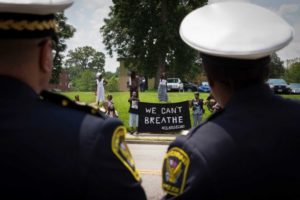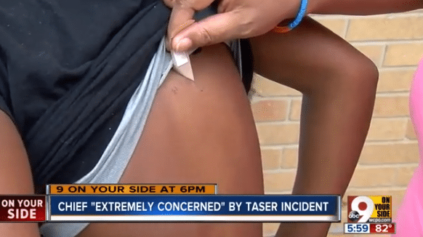Police officers lie for each other in order to cover up grave injustices, and the latest case in Cincinnati is proof of that.
Nearly one year since the death of Michael Brown in Ferguson and the birth of a Black-led movement against police violence, a white police officer has been indicted for the murder of a Black man. Further, it is widely held that the body camera the officer was wearing—which wholly contradicted his claim that he acted in self-defense—led to his indictment.
On July 29, University of Cincinnati police officer Ray Tensing was indicted in the July 19 murder of Samuel DuBose, 43, another unarmed Black motorist in a traffic stop incident. In this case, Dubose allegedly had a missing front license plate, as CNN reported. DuBose was a father of 10.
Tensing was immediately fired by the University of Cincinnati, and he surrendered to police. If convicted, Tensing could face life in prison.
According to The Guardian, police officers in Cincinnati apparently corroborated Tensing’s false account of the shooting death of DuBose immediately following the incident. The officer claimed he was dragged by DuBose’s car during the traffic stop, at which point he had to open fire, killing the man with a shot to the head.
On three occasions throughout the video, The Guardian notes, two other police officers repeat Tensing’s account that DuBose dragged him. Further, one of the cops even claims he witnessed the dragging incident.
An information report written by University of Cincinnati police officer Eric Weibel, reads: “Officer Kidd told me that he witnessed the Honda Accord [DuBose’s vehicle] drag Officer Tensing, and that he witnessed Officer Tensing fire a single shot.”
The report further states: “Looking at Officer Tensing’s uniform, I could see that the back of his pants and shirt looked as if it had been dragged over a rough surface.”
Sanitizing, covering up and lying about brutality by police officers is nothing new—the case of Ray Tensing is but one of many examples. As Nick Wing points out in The Huffington Post, it is clear that regarding the use of force, the police and the community have extremely different interpretations of the same incidents. While some cases may be an honest difference of opinion, when the definition of “excessive” is in the hands of an internal review process, police are given much leeway, and the outrageous is justified under the law.
“A number of high-profile cases over the past few years suggest that something even more disturbing can happen when police are given the responsibility of self-reporting violence,” Wing notes.
He points to various instances that, “offer clear evidence of cops — and in some cases, their superiors—attempting to sanitize, mischaracterize or simply lie about the use of force.”
“They raise disquieting questions about what might have happened if videos of the incidents had never surfaced—and how many similar incidents never become known to the public,” Wing says.
At a news conference, Hamilton County, Ohio Prosecutor Joe Deters played body camera video footage of the traffic stop and the subsequent shooting, which contradicted Tensing’s account of what occurred. He said that of the 100 police shootings his office has reviewed, this was the only case where they concluded, “This is without question a murder.”

Cincinnati Police Chief Jeffrey Blackwell, left, looks at protestors across the street from funeral services for Samuel Dubose at the Church of the Living God in the Avondale neighborhood of Cincinnati, Tuesday, July 28, 2015. Dubose was fatally shot by a University of Cincinnati police officer who stopped him for a missing license plate. Photo: John Minchillo, AP
Deters added that in all of his career, he’s never witnessed a cop behave so poorly.
“I’ve been doing this for over 30 years. This is the most asinine act I’ve ever seen a police officer make—totally unwarranted,” Deters added. “It’s an absolute tragedy in the year 2015 that anyone would behave in this manner. It was senseless.”
The prosecutor also insisted that DuBose did not act aggressively toward Tensing.
“People want to believe that Mr. DuBose had done something violent towards the officer—he did not. He did not at all. I feel so sorry for his family and what they lost, and I feel sorry for the community, too,” Deters said.
For Deters—a white Republican official criticized for his brash manner and bad relationship with the Black community—the indictment served as a turning point of sorts, leading to reactions of surprise and relief from the Black community.
As BuzzFeed News reported, Deters’ opponents have accused him of using his office for personal vendettas and making inflammatory statements about Black defendants.
“Deters has historically been at odds with the Black community,” Aaron Roco, a Black Lives Matter Cincinnati organizer, told BuzzFeed News. “We’re [not] fans of Joseph Deters. We’re happy with what he’s done today, but that may be the only thing.”
“The relationship between the Black community and Joseph Deters is strained, at best,” aded Janaya Trotter Bratton, criminal justice chair for the Greater Cincinnati Chapter National Action Network. “The press conference he gave today is usually the press conference he gives on day one with a Black defendant.”
The public expected the bodycam video, which had been withheld from release, would be shocking.
“The video is not good,” Cincinnati police chief Jeffrey Blackwell told WCPO in Cincinnati two days before the indictment. “I think the city manager has said that also publicly. I’ll leave it there.”
City Manager Harry Black weighed in as well.
“It’s not a good situation,” Black said. “It’s a tragic situation, someone has died that did not necessarily need to die.”
“There was no transparency, no grace towards the family,” said Iris Roley, a leader of the Cincinnati Black United Front, regarding the lack of transparency in delaying release of the bodycam footage.

Audrey Dubose, mother of Samuel Dubose, speaks to the media following funeral services at the Church of the Living God in the Avondale neighborhood of Cincinnati, Tuesday, July 28, 2015. Dubose was fatally shot by a University of Cincinnati police officer who stopped him for a missing license plate. Photo: John Minchillo, AP
“I’m so thankful that everything was uncovered,” said Audrey DuBose, the victim’s mother, at a news conference. “I thought it was going to be covered up. I heard many stories and everything. But… I trust God, and I knew everything was going to be all right,” she added, saying she could forgive Tensing if he asked for forgiveness.
“Sam was a peaceful person,” said Mark O’Mara, attorney for the DuBose family and lead defense attorney for George Zimmerman, the Florida neighborhood watchman who was acquitted in the 2012 death of Black teen Trayvon Martin. “We do not want any violence, any anger to come out in a way that denigrates who he was and who he wanted to be remembered as.”
According to a database maintained by The Washington Post, there have been 558 fatal shootings by police so far this year, of which 57 victims were unarmed, and 20 had a toy gun. In addition, at least 95 people have been shot to death in the past 30 days. The recent killing of Samuel DuBose marks only the fourth criminal prosecution of a police officer in 2015. All four shootings were captured on video, and three involved white cops shooting Black men, including the April 4 killing of Walter Scott, who was shot in the back by a North Charleston, S.C. police officer. One shooting involved a white victim. This reality tells us that police officers are prosecuted only in rare cases, and that video evidence of a shooting can make a difference.
Although the bodycam footage did not save the life of Mr. DuBose, it may very well have secured this speedy indictment, and possible conviction of ex-Officer Ray Tensing. Had there not been a recording of what had transpired, Tensing’s account, made up out of whole cloth, may have prevailed. We will never know how many more Black bodies remain uncounted, but we do know there are many.
In the meantime, what are the implications for a society whose law enforcement officers are willing to fabricate and manufacture the “truth” to their liking? And what about the blue wall of silence, which would allow a murderer with a badge and a gun to roam free and interact with the public—a criminal impersonating a public servant?
If this means that citizens are in danger, then Black citizens are in the most danger. This is what the Black Lives Matter movement is all about—this system of oppression must be toppled.



